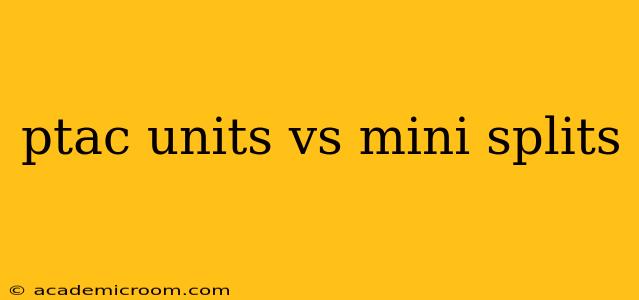Choosing the right climate control system for your building can be a daunting task. Two popular options often top the list: PTAC units (Packaged Terminal Air Conditioners) and mini-split systems. Both offer heating and cooling, but their functionality, installation, and long-term costs differ significantly. This comprehensive guide will delve into the key differences between PTAC units and mini-splits, helping you make an informed decision.
What is a PTAC Unit?
PTAC units are self-contained heating and cooling systems typically found in hotels, motels, and some apartments. They are installed through a single, relatively small hole in the wall, making them easy to install and replace. They are all-in-one units, meaning the condenser, evaporator, and other components are housed within a single cabinet. This simplifies maintenance, but also limits flexibility in terms of placement and design.
What is a Mini-Split System?
Mini-split systems, on the other hand, consist of two main components: an indoor unit (air handler) and an outdoor unit (condenser). The units are connected by refrigerant lines, offering greater flexibility in placement. This allows for more precise climate control in specific zones, unlike PTAC units which typically cool or heat an entire room. Mini-splits are known for their energy efficiency and quiet operation.
PTAC Units vs. Mini Splits: Key Differences
Here's a head-to-head comparison of the major features:
| Feature | PTAC Unit | Mini-Split System |
|---|---|---|
| Installation | Simple, through a single wall opening | More complex, requires refrigerant lines |
| Efficiency | Generally less energy-efficient | Generally more energy-efficient |
| Noise Level | Can be noisy | Typically quieter |
| Maintenance | Relatively easy | Requires professional maintenance |
| Cost | Lower initial cost | Higher initial cost |
| Flexibility | Limited placement options | Greater placement flexibility |
| Zoning | No zoning capabilities | Zoning capabilities available |
What are the pros and cons of PTAC units?
Pros:
- Ease of Installation: Relatively quick and straightforward installation.
- Lower Initial Cost: Typically cheaper upfront than mini-split systems.
- Simple Maintenance: Easier to access and maintain components.
- Easy Replacement: Replacing a faulty unit is generally simpler.
Cons:
- Lower Energy Efficiency: Usually consume more energy compared to mini-splits.
- Noisy Operation: Can be significantly louder than mini-split systems.
- Limited Flexibility: Placement options are restricted by wall openings.
- Less Precise Temperature Control: Cannot easily control temperature in different zones.
What are the pros and cons of mini-split systems?
Pros:
- High Energy Efficiency: Generally more energy-efficient, leading to lower operating costs.
- Quiet Operation: Significantly quieter than PTAC units.
- Flexibility in Placement: Indoor units can be located almost anywhere.
- Zoning Capabilities: Allows for independent temperature control in different zones.
- Improved Air Quality: Some models offer advanced filtration.
Cons:
- Higher Initial Cost: Installation and equipment costs are significantly higher.
- More Complex Installation: Requires professional installation and refrigerant lines.
- More Complex Maintenance: Maintenance usually requires a qualified technician.
- Aesthetic Considerations: Indoor units are visible and may affect the decor.
Are mini-splits more efficient than PTAC units?
Yes, generally mini-split systems are significantly more energy-efficient than PTAC units. This is due to their advanced technology, inverter compressors, and better heat exchange capabilities. The energy savings can translate to substantial cost reductions over the lifespan of the system.
Which is better for hotels?
The best choice for hotels often depends on the specific needs and budget. PTAC units are often preferred due to their ease of installation and replacement in individual rooms. However, hotels aiming for increased energy efficiency and guest comfort may opt for mini-split systems, despite the higher initial investment. The long-term energy savings can justify the higher upfront cost.
Which is better for apartments?
For apartments, both PTAC units and mini-splits are viable options. PTAC units are common in older buildings due to their ease of installation. However, newer apartment buildings may opt for mini-splits for their improved efficiency and quiet operation, particularly in larger units where zoning could be beneficial.
Which is easier to install?
PTAC units are far easier to install than mini-split systems. Their self-contained design requires only a single wall opening, while mini-splits require professional installation of refrigerant lines and more complex electrical work.
Ultimately, the best choice between a PTAC unit and a mini-split system depends on your specific needs, budget, and the characteristics of your space. Consider factors like energy efficiency, noise levels, installation complexity, and long-term costs when making your decision. Consulting with a qualified HVAC professional is recommended to determine the ideal solution for your situation.
